To tame bitterness in your herbal tea blends, you've got several effective options. Start by adding sweet herbs like stevia or licorice root to balance harsh flavors. Citrus elements, such as lemon or orange peel, can brighten and soften the taste. Mint family herbs are excellent for masking bitterness, while floral notes like chamomile or lavender add complexity. Pay attention to your herb-to-water ratio and steeping time to avoid over-extraction. Cold brewing can result in a smoother taste. Natural sweeteners like honey or cinnamon can enhance flavors without overpowering. By exploring these techniques, you'll reveal the secret to perfectly balanced herbal teas.
Understanding Bitterness in Herbal Teas
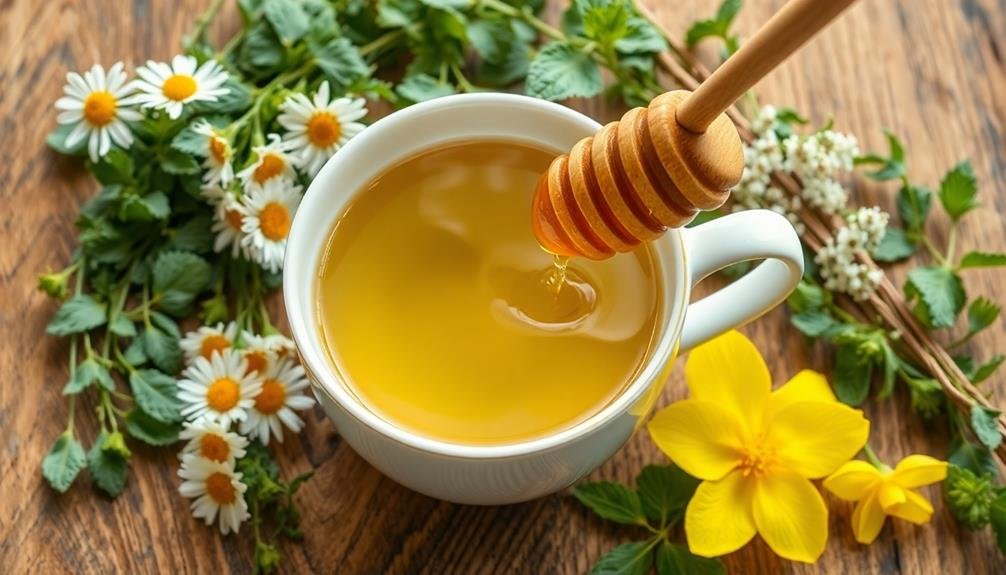
Identifying the source of bitterness in herbal teas is essential for creating balanced blends. You'll find that bitterness often comes from tannins, alkaloids, or other compounds present in certain herbs. Common culprits include dandelion root, yellow dock, and some types of mint.
These bitter elements can be beneficial, as they may aid digestion and stimulate appetite, but they can also overpower other flavors if not managed carefully.
To understand bitterness, you'll need to familiarize yourself with the flavor profiles of different herbs. Taste each herb individually to identify its unique characteristics.
You'll notice that some herbs, like chamomile and lemon balm, have a naturally sweet or mild taste, while others, such as nettle or yarrow, can be quite bitter.
The brewing process also affects bitterness. Steeping herbs for too long or at too high a temperature can extract more bitter compounds.
Water quality and mineral content can influence the perception of bitterness as well. By understanding these factors, you'll be better equipped to create herbal tea blends that balance bitterness with other flavors, resulting in a more enjoyable and harmonious cup.
Sweet Herbs for Flavor Balance
When balancing bitter flavors in your herbal tea blends, you'll find several naturally sweet herbs invaluable.
Stevia, known as nature's sweet leaf, can provide intense sweetness without adding calories.
You can also incorporate licorice root for its candied notes or honeybush for a gentler, honey-like sweetness.
Stevia: Nature's Sweet Leaf
Among the sweet herbs that can balance bitterness in herbal teas, stevia stands out as a powerful natural sweetener. This South American plant has been used for centuries to add sweetness without calories or negative impacts on blood sugar levels. You'll find stevia available in various forms, including fresh leaves, dried leaves, and liquid extracts.
When using stevia in your tea blends, remember that it's much sweeter than sugar—about 30 to 150 times sweeter, depending on the variety and preparation. Start with a small amount and adjust to taste. Fresh or dried stevia leaves can be steeped directly with your other herbs, while liquid extracts should be added after brewing.
Stevia pairs well with many herbs, especially those with naturally bitter or tart flavors like dandelion, hibiscus, or lemon balm. It can also enhance the sweetness of already mild herbs like chamomile or peppermint.
When blending, consider stevia's potential to overpower other flavors. Use it judiciously to achieve a balanced taste profile in your herbal tea creations.
Licorice Root's Candied Notes
Licorice root's natural sweetness makes it a valuable addition to herbal tea blends, especially when you're aiming to tame bitter flavors. This herb's unique candied notes can transform harsh tastes into smooth, palatable brews. You'll find that licorice root not only sweetens but also adds depth and complexity to your tea.
When incorporating licorice root into your blends, keep these points in mind:
- Use sparingly – a little goes a long way due to its potent sweetness
- Pair with mint or fennel for a revitalizing, digestive-friendly blend
- Combine with bitter herbs like dandelion or chicory to balance flavors
- Consider brewing time – longer steeping enhances sweetness
Licorice root contains glycyrrhizin, a compound 50 times sweeter than sugar. This natural sweetener can help you reduce or eliminate the need for added sugars in your tea. It's particularly effective in masking the bitterness of medicinal herbs, making therapeutic blends more enjoyable.
However, be aware that excessive consumption of licorice root can lead to side effects, so moderation is key. By thoughtfully incorporating this sweet herb, you'll create balanced, flavorful tea blends that delight your taste buds.
Honeybush's Gentle Sweetness
Alongside licorice root, honeybush stands out as another sweet herb that can help balance flavors in herbal tea blends. This South African shrub produces leaves and stems that, when brewed, offer a naturally sweet taste without added calories.
You'll find honeybush's flavor profile to be milder and more delicate than licorice root, making it an excellent choice for those who prefer a subtler sweetness.
When you're crafting herbal tea blends, honeybush can be your go-to for tempering bitter notes from herbs like dandelion root or chicory. Its gentle sweetness won't overpower other flavors but will instead create a harmonious balance.
You'll also appreciate honeybush's slightly honey-like aroma, which adds depth to your blend's overall sensory experience.
To incorporate honeybush effectively, start by adding small amounts to your blend and adjust to taste. It pairs well with fruity and floral herbs, enhancing their natural sweetness.
You can also use honeybush as a base for caffeine-free chai blends, where its sweetness complements warming spices like cinnamon and cardamom.
Citrus Additions to Counteract Bitterness
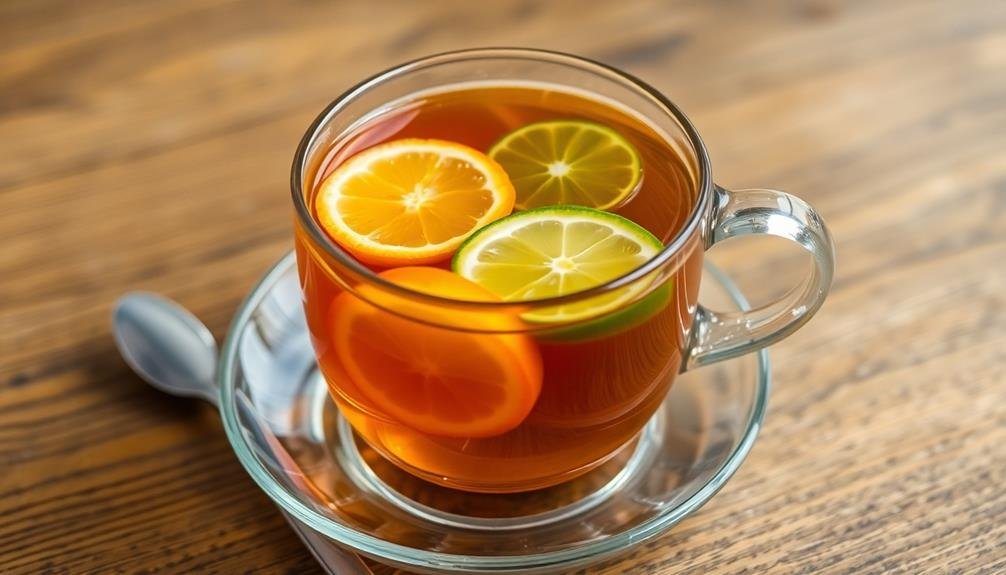
Citrus fruits offer a bright, tangy counterpoint to bitter flavors in herbal tea blends. When you're looking to balance out the sharpness of certain herbs, consider adding a touch of citrus to your mix. Lemon, lime, orange, and grapefruit can all work wonders in taming bitterness while introducing a revitalizing zest to your brew.
The acidity in citrus fruits helps neutralize bitter compounds, creating a more harmonious flavor profile. You'll find that even a small amount of citrus can make a significant difference. Try adding dried citrus peel or a few drops of essential oil to your blend for a subtle yet effective balance.
Here's how citrus can transform your herbal tea experience:
- Lemon balances bitter green teas, enhancing their natural flavors.
- Orange peel adds warmth and sweetness to spicy blends.
- Lime zest brings a tropical twist to floral teas.
- Grapefruit essence cuts through rich, earthy notes in root-based teas.
When incorporating citrus, start with small amounts and adjust to taste. You'll soon discover the perfect balance that suits your palate and complements your chosen herbs.
Mint Family as Taste Enhancers
Members of the mint family offer a revitalizing solution to balance bitterness in herbal tea blends. You'll find that peppermint, spearmint, and other mint varieties can effectively mask and complement bitter flavors while adding a stimulating twist to your brew.
When you're looking to tame bitterness, consider incorporating peppermint leaves. Their strong, cool flavor profile can overpower and neutralize unpleasant tastes. Spearmint, with its milder and sweeter notes, provides a gentler approach to enhancing your tea's overall flavor.
Don't overlook other mint family members like lemon balm, which adds a subtle citrusy undertone, or catnip, known for its calming properties. These herbs can contribute unique flavors while helping to mellow out bitter notes.
You can experiment with different ratios of mint to bitter herbs to find your perfect balance. Start with a small amount and gradually increase until you achieve the desired taste.
Remember that mints can be potent, so a little goes a long way. By incorporating these aromatic herbs, you'll transform your bitter tea blend into a more palatable and invigorating beverage.
Floral Notes for Softening Blends

When seeking to soften bitter herbal tea blends, floral notes offer a delicate and aromatic solution. These gentle flavors can balance strong tastes while adding complexity to your brew. Flowers like chamomile, lavender, and rose petals aren't just pretty; they're powerful allies in creating a harmonious tea experience.
Here's how floral notes can transform your bitter blends:
- Chamomile's apple-like sweetness mellows harsh flavors.
- Lavender's soothing aroma calms both the palate and mind.
- Rose petals add a subtle sweetness and romantic essence.
- Jasmine's exotic fragrance masks unpleasant undertones.
You'll find that incorporating these floral elements doesn't just mask bitterness; it creates a more layered and sophisticated flavor profile.
Start with small amounts and adjust to taste. Remember, a little goes a long way with floral ingredients. You can also experiment with dried flower buds or essential oils for a more concentrated effect.
Spices That Complement Bitter Flavors
Spices can turn the tables on bitter flavors, transforming them from off-putting to intriguing. When you're crafting herbal tea blends, consider adding spices that complement and balance bitterness. Cinnamon, for example, brings warmth and sweetness that can soften harsh notes. Ginger adds a zesty kick that distracts from bitterness while enhancing overall complexity.
Don't overlook the power of cardamom, which imparts a unique, aromatic sweetness. Its complex flavor profile can mask bitterness while adding depth to your blend. Cloves, with their intense, sweet-spicy taste, can also work wonders in small amounts.
Here's a quick reference guide for spices that pair well with bitter herbs:
| Spice | Flavor Profile | Best Paired With |
|---|---|---|
| Cinnamon | Warm, sweet | Dandelion, chicory |
| Ginger | Spicy, zesty | Burdock, yellow dock |
| Cardamom | Sweet, aromatic | Milk thistle, nettle |
Experiment with these spices in small quantities, as they can quickly overpower other flavors. You'll find that the right combination can turn a bitter brew into a balanced, sophisticated herbal tea that's both enjoyable and beneficial.
Fruity Elements in Tea Blends
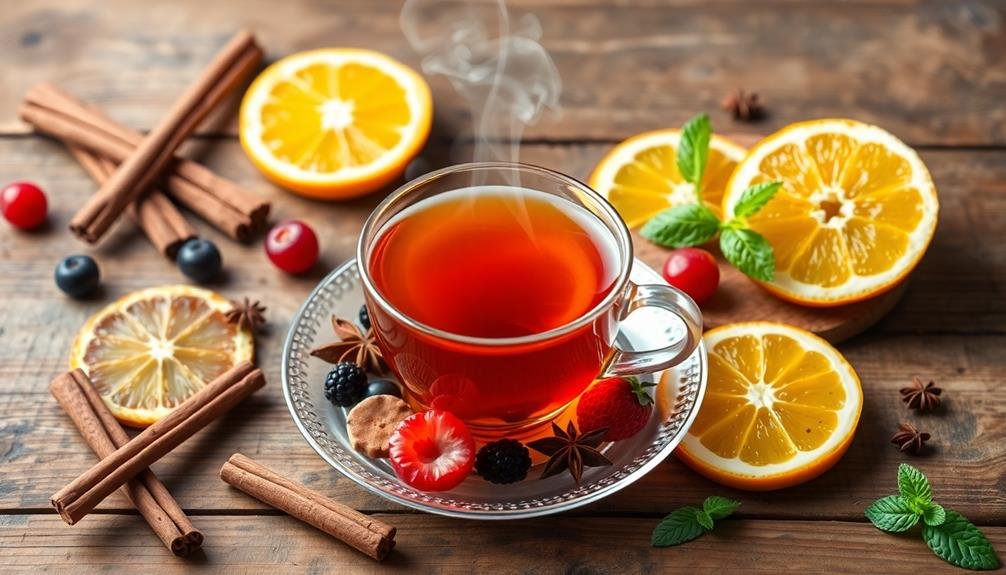
When crafting tea blends to balance bitterness, you'll find fruity elements to be powerful allies.
You can brighten your blend with citrus zest additions, introduce sweetness through berry-infused combinations, or add complexity with tropical fruit flavors.
These fruity components not only mask bitterness but also create more nuanced and appealing taste profiles in your herbal teas.
Citrus Zest Additions
A dash of citrus zest can work wonders in balancing the bitterness of herbal tea blends. The bright, aromatic oils found in citrus peels add a revitalizing note that can complement and soften harsh flavors.
When you're looking to tame bitterness in your herbal teas, consider adding lemon, lime, orange, or grapefruit zest to your blend.
Citrus zest doesn't just mask bitterness; it actually interacts with bitter compounds, reducing their impact on your taste buds. You'll find that even a small amount of zest can greatly improve the overall flavor profile of your tea.
To incorporate citrus zest effectively:
- Use fresh zest whenever possible for the most vibrant flavor
- Add zest sparingly, as a little goes a long way
- Experiment with different citrus varieties to find your perfect match
- Combine zest with other ingredients like honey or mint for complex flavors
Berry-Infused Tea Blends
While citrus zest can brighten herbal teas, berry-infused blends offer a delightful alternative for taming bitterness. You'll find that berries bring a natural sweetness and vibrant flavor to your tea, effectively masking any harsh notes. Incorporate dried berries like strawberries, blueberries, or raspberries into your blend for a burst of fruity goodness.
When creating berry-infused teas, aim for a balance between the herbal base and the fruit. Start with a ratio of 2:1 herbs to berries, adjusting as needed. You can use fresh berries for a more intense flavor, but dried berries are more convenient and have a longer shelf life. If you're using fresh berries, muddle them slightly before adding to release their juices.
Consider pairing berries with complementary herbs like chamomile, mint, or lemon balm. These combinations can create complex flavor profiles while still keeping bitterness at bay.
You'll also find that berry-infused teas are naturally sweet, reducing the need for added sweeteners. Experiment with different berry combinations to discover your perfect blend, and enjoy the fruity transformation of your herbal tea experience.
Tropical Fruit Flavors
Beyond the domain of berries, tropical fruit flavors offer an exotic twist to herbal tea blends, effectively combating bitterness. These vibrant tastes transport you to sun-soaked islands, providing a revitalizing counterpoint to more astringent herbs. Pineapple, mango, papaya, and passion fruit are popular choices that bring natural sweetness and complexity to your cup.
When incorporating tropical fruits into your blends, you'll notice they:
- Introduce a bright, tangy profile that masks bitter notes
- Add a natural sweetness, reducing the need for additional sweeteners
- Provide a juicy mouthfeel that complements drier herbs
- Offer a fragrant aroma that enhances the overall sensory experience
To maximize the impact of tropical fruit flavors, opt for freeze-dried or air-dried fruits rather than artificial flavorings. These preserve the fruit's natural essence without introducing unwanted chemicals.
You can also experiment with combining different tropical fruits to create unique flavor profiles. For example, try blending mango with a hint of coconut or pairing pineapple with a touch of lime. These combinations not only tame bitterness but also elevate your herbal tea to a gourmet experience.
Steeping Time and Temperature Considerations
For ideal flavor and reduced bitterness, steeping time and temperature play essential roles in herbal tea preparation. You'll find that different herbs require varying steeping times and temperatures to extract their best flavors while minimizing bitterness.
Generally, you should steep most herbal teas in water that's just under boiling point (around 200°F or 93°C) for 5-7 minutes. However, delicate herbs like chamomile or mint benefit from slightly cooler water (around 190°F or 88°C) and shorter steeping times of 3-5 minutes.
Robust herbs like ginger or rosehip can handle boiling water and longer steeping times of up to 10 minutes.
To avoid over-extraction and bitterness, always remove the herbs or tea bags after the recommended steeping time. If you prefer stronger tea, it's better to use more herbs rather than steeping longer.
You can also experiment with cold brewing, which often results in a smoother, less bitter taste. Simply steep your herbs in cold water for 8-12 hours in the refrigerator.
Proper Herb-to-Water Ratio

To achieve the perfect balance in your herbal tea, you'll need to measure your herbs accurately.
You can start by using about 1 teaspoon of dried herbs per cup of water, adjusting this ratio for stronger flavors like mint or ginger.
Remember that the herb-to-water ratio also affects steeping time, so you may need to experiment to find your ideal combination.
Measuring Herbs Accurately
Precision is key when it comes to measuring herbs for your tea blends. Accurate measurements guarantee a consistent flavor profile and help prevent bitterness from overpowering your brew. You'll want to invest in a reliable kitchen scale that can measure in grams, as this provides the most accurate results for herbal teas.
When measuring herbs, consider their form:
- Whole leaves: Measure by weight, not volume, as they can vary in size and density.
- Crushed or cut herbs: Use a tablespoon measure, but don't pack them tightly.
- Powdered herbs: Measure with a teaspoon, as they're more concentrated.
- Flowers and buds: Use a tablespoon, but measure loosely to account for air pockets.
Remember that different herbs have varying potency levels, so you'll need to adjust your measurements accordingly. Start with smaller amounts of strong herbs like peppermint or chamomile, and increase gradually to find your perfect balance.
Keep a tea journal to record your measurements and tasting notes, allowing you to refine your blends over time. With practice, you'll develop an intuitive sense for measuring herbs accurately, resulting in consistently delicious and balanced herbal teas.
Balancing Strong Flavors
Mastering the art of balancing strong flavors in herbal tea blends hinges on achieving the proper herb-to-water ratio. You'll find that using too much herb can result in an overly bitter or intense brew, while too little may produce a weak, unsatisfying tea.
Start by using 1 to 2 teaspoons of dried herbs per cup of water as a general guideline. For stronger herbs like peppermint or ginger, you might want to use less, while milder herbs like chamomile may require more. Experiment with different ratios to find your preferred strength.
Remember that steeping time also affects flavor intensity. Steep robust herbs for 3-5 minutes, and delicate ones for 1-3 minutes.
When working with multiple herbs, consider their individual strengths. Combine stronger flavors with milder ones to create a balanced blend. For example, pair bitter dandelion root with sweet licorice or cinnamon to offset its intensity.
You can also add a small amount of honey or stevia to counteract bitterness without overwhelming the herbal flavors. By fine-tuning your herb-to-water ratio and blending techniques, you'll create harmonious tea blends that showcase the best of each ingredient.
Steeping Time Considerations
Steeping time plays an essential role in achieving the perfect balance of flavors in your herbal tea blend. When you're working with bitter herbs, it's vital to pay attention to how long you let them steep. Oversteeping can intensify bitterness, while understeeping mightn't extract enough of the desired flavors.
To find the right steeping time for your blend, consider these factors:
- The type of herbs you're using
- The size of the herb pieces (whole leaves, crushed, or powdered)
- The water temperature
- Your personal taste preferences
Start with a shorter steeping time, around 3-5 minutes, and taste your tea. If it's not strong enough, gradually increase the steeping time in 30-second increments until you reach the desired flavor intensity.
Remember that some herbs, like chamomile or peppermint, are more forgiving and can steep for longer without becoming bitter. Others, such as green tea or certain roots, may turn bitter quickly if left too long.
Keep a record of your ideal steeping times for different blends to guarantee consistent results. By mastering the art of steeping, you'll be able to create perfectly balanced herbal teas every time.
Balancing Strong and Mild Herbs
When crafting herbal tea blends, balancing strong and mild herbs is essential for achieving a harmonious flavor profile. You'll want to carefully consider the intensity of each herb's taste and aroma to create a well-rounded blend. Strong herbs, like peppermint or ginger, can easily overpower milder ones, so use them sparingly.
Start by selecting a base herb with a mild flavor, such as chamomile or lemon balm. Then, add small amounts of stronger herbs to enhance the taste without dominating it. You can experiment with different ratios to find the perfect balance. Remember, it's easier to add more of a strong herb later than to correct an overpowering blend.
| Strong Herbs | Mild Herbs |
|---|---|
| Peppermint | Chamomile |
| Ginger | Lemon Balm |
| Rosemary | Lavender |
| Thyme | Rose Petals |
When combining herbs, consider their flavor profiles. Pair complementary tastes, such as floral with citrus or spicy with sweet. This approach will help you create a more complex and interesting blend. Don't forget to taste your creation frequently during the blending process, adjusting the ratios as needed to achieve the desired balance.
Cold Brewing for Smoother Taste
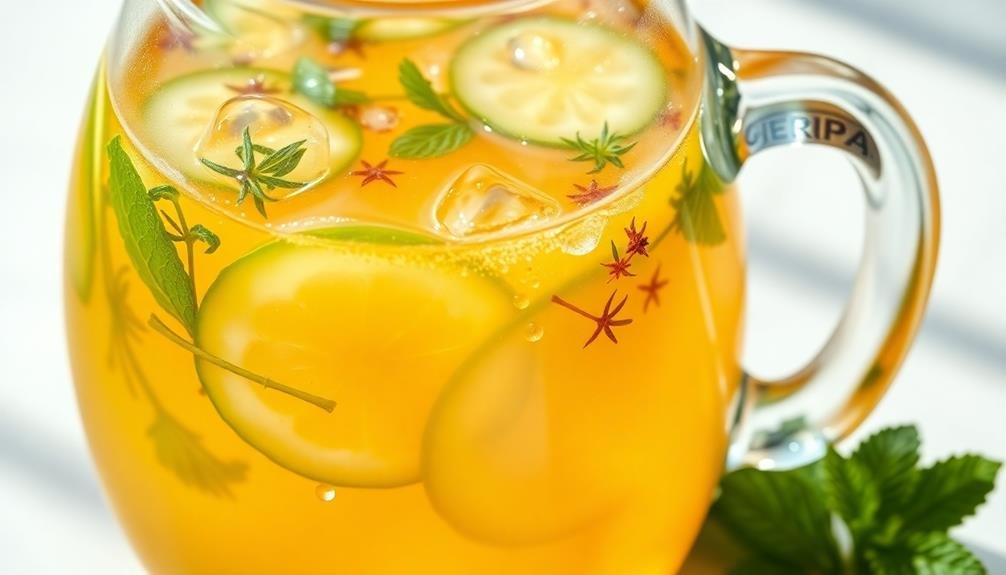
Cold brewing offers another approach to taming bitterness in herbal tea blends. This method involves steeping your herbs in cold water for an extended period, typically 8-12 hours, rather than using hot water. The result is a smoother, less bitter taste that brings out the subtle flavors of your herbs without extracting as many tannins and other bitter compounds.
To cold brew your herbal tea blend:
- Place your herbs in a glass jar or pitcher
- Add cold or room temperature water
- Cover and refrigerate for 8-12 hours
- Strain and enjoy over ice or heated
Cold brewing works particularly well for herbs that tend to be naturally bitter, such as chamomile, mint, and lemon balm. You'll find that the flavors are more delicate and nuanced compared to hot-brewed versions.
This method also allows you to experiment with different ratios of herbs, as the extended steeping time can help balance stronger flavors. Remember, you can always adjust the steeping time to achieve your desired strength and taste profile.
If you're looking for a revitalizing summer drink or a gentler way to enjoy your favorite herbal blends, cold brewing is definitely worth trying.
Natural Sweeteners in Herbal Teas
Natural sweeteners provide an excellent way to balance bitterness in herbal teas without resorting to refined sugars.
You'll find that honey is a popular choice, offering a rich flavor that complements many herbs while providing antibacterial properties.
Stevia, a plant-based sweetener, is another option that's calorie-free and doesn't spike blood sugar levels. It's potent, so use it sparingly to avoid overpowering your tea's natural flavors.
For a more subtle sweetness, try adding licorice root to your blend. It naturally sweetens without altering the tea's overall taste profile.
Cinnamon and fennel seeds can also lend a sweet note while contributing their unique flavors.
If you prefer fruit-based sweeteners, dried berries or a splash of fruit juice can add both sweetness and a vibrant flavor dimension to your tea.
When using natural sweeteners, remember that less is often more.
Start with small amounts and adjust to taste. You'll want to maintain the delicate balance of flavors in your herbal blend while taming any unwanted bitterness.
Experiment with different combinations to find your perfect sweet spot in herbal tea blending.
Frequently Asked Questions
Can Bitter Herbs in Tea Have Health Benefits?
Yes, bitter herbs in your tea can offer health benefits. They're often rich in antioxidants and may aid digestion, boost immunity, and support liver function. However, you shouldn't overdo it, as too much bitterness can be unpleasant.
How Do Different Water Sources Affect the Taste of Herbal Teas?
You'll notice that water sources greatly impact your herbal tea's taste. Hard water can mute flavors, while soft water enhances them. Filtered water often produces the best results, allowing you to fully experience your tea's nuanced profile.
Are There Any Herbs That Should Never Be Mixed Together?
You'll want to avoid mixing herbs with opposing effects, like stimulants and sedatives. Don't combine St. John's Wort with other medications, as it can interfere with their effectiveness. Always research potential interactions before blending herbs for safety.
Can Herbal Teas Be Used as a Base for Cocktails?
Yes, you can use herbal teas as cocktail bases. They'll add unique flavors and aromas to your drinks. Try mixing chamomile with gin, mint tea with rum, or lavender tea with vodka. You'll create delicious, aromatic cocktails with a twist.
How Long Can Dry Herbal Tea Blends Be Stored?
You can store dry herbal tea blends for up to a year if kept in airtight containers away from light, heat, and moisture. It's best to use them within six months for ideal flavor and potency.
In Summary
You've now got a toolkit to tame bitterness in your herbal teas. Remember, it's all about balance. Experiment with sweet herbs, citrus, mint, and floral notes to soften harsh flavors. Don't forget about proper ratios and brewing techniques. Cold brewing can work wonders for smoother taste. And if you need a touch more sweetness, natural sweeteners are your friend. With these tips, you'll be crafting delightful, balanced blends in no time.


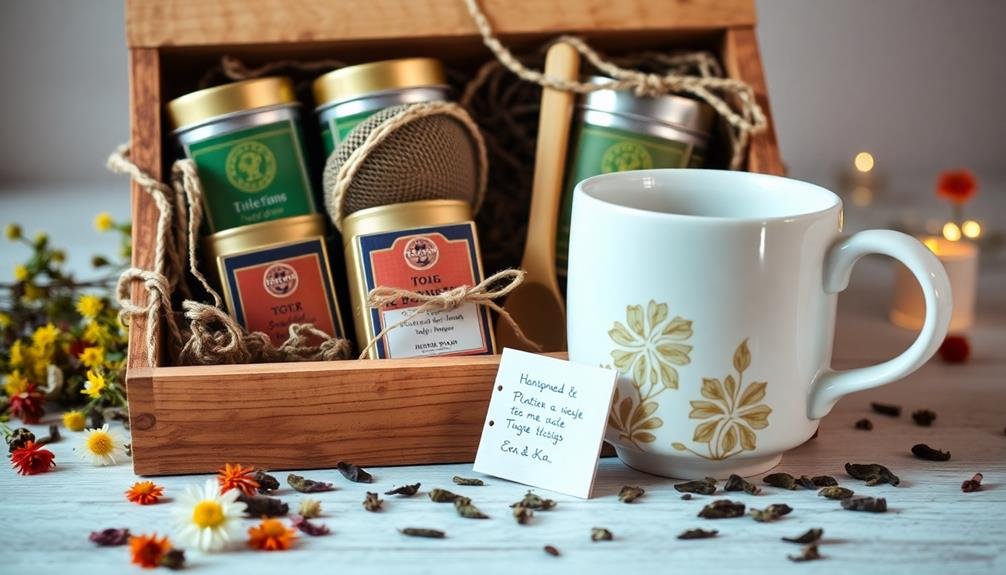
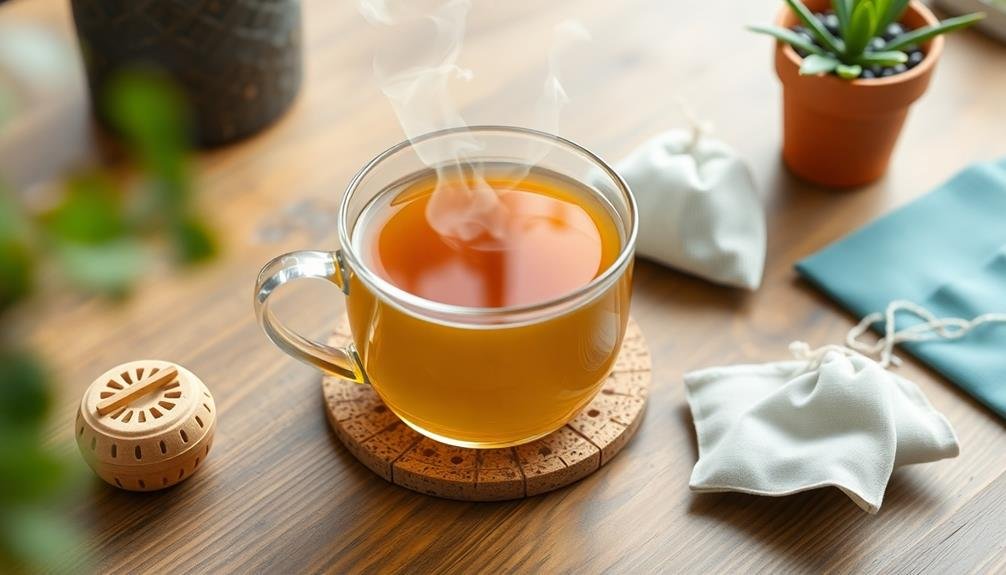
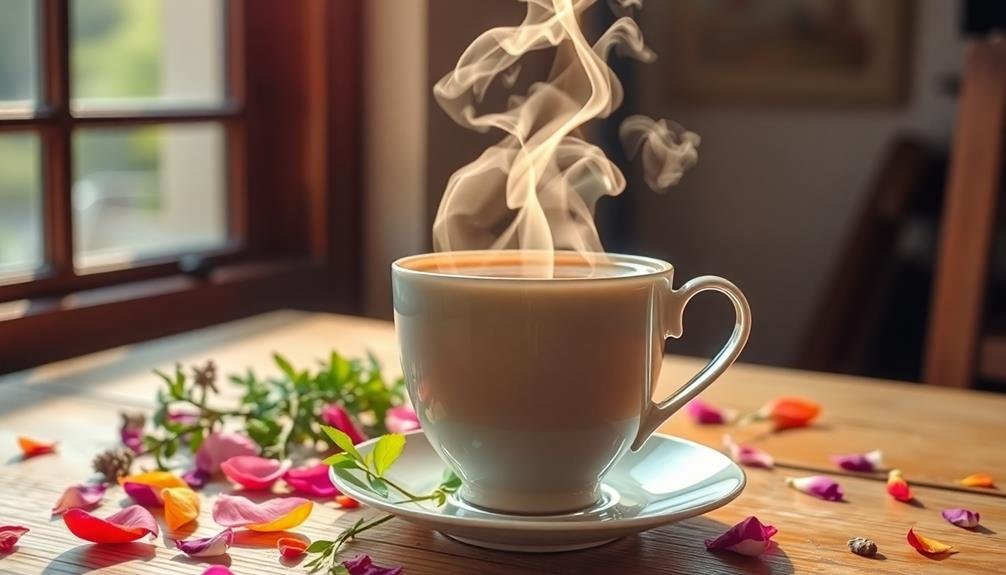
Leave a Reply